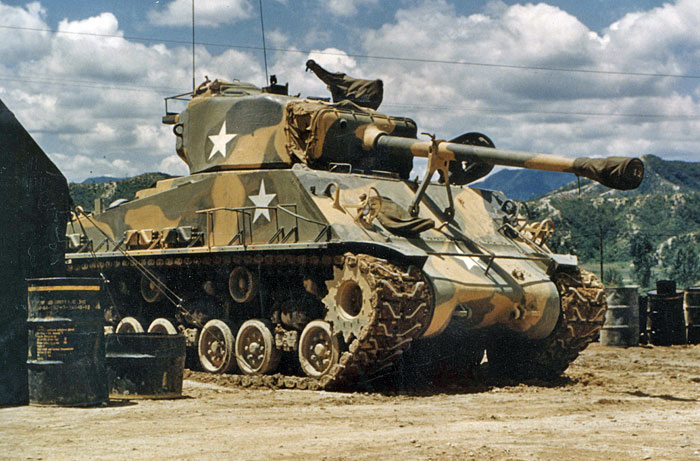
M4A3E8 Sherman “Easy Eight”
In America a much more rational designation system was used.
In the project, design, and development stages, a vehicle was given a
designation in the T series (best remembered as T for Test). Thus a vehicle
might be designated T89. Any experimental modification was indicated by a
suffix in the E series (E for Experimental). Thus T1E1, T25E1, or T20E3, in the
latter case the “3” indicating the third experimental modification.
“T” numbers were normally allocated chronologically. When fully
accepted for service by the using arms, the vehicle was “standardised”
and given a designation in the M series. Thus M6 or M8. It was not usual for
the M number to bear any relation to the original T designation, but towards
the end of the war there was a change in favour of this in an attempt to avoid
confusion. Thus the Light Tank T24 became the M24 on standardisation, for
example. In rare instances a design was standardised from the “drawing
board” and never received a T designation; an example was the Medium Tank
M3. There were also many instances where vehicles were put into limited production
and service before being standardised, and in some cases they never achieved
the status of standardisation -an example being the T23 medium tank.
At this stage it must be emphasised that this system of
designation was used for every item of military equipment in the US Army, so
that it was possible to have an M3 Medium tank, an M3 Light tank, an M3 gun
mount, an M3 rifle, an M3 flame-gun, an M3 gun sight and so on. Thus it was
normal practice to qualify each item by its full title. Strictly speaking,
therefore, it is necessary to say Light Tank M3 to distinguish it from Medium
Tank M3 and so on, was indicated by an “A” suffix. An example of this
is seen clearly in the Medium Tank M4 series, where engine and other changes
gave rise to the M4A1, M4A2, M4A3 etc. Modifications confined to the chassis
only were indicated by a “B” series suffix. An example arises in M7
howitzer motor carriage development. The M7 was based on the M3 medium tank
chassis, and the same design based on the M4A3 chassis became the M7B2. Had yet
another chassis been used subsequently, the designation would have been M7B2,
and so on. The “E” series suffix was rarely retained when a design
was standardised, but there were exceptions, one such being Assault Tank
M4A3E2. It should be borne in mind that any special purpose equipment carried
on American tanks was designated separately but following the same system. Thus
an M4A1 tank could be seen fitted with an MI dozer blade or a T34 rocket
launcher, etc.
Self-propelled artillery in American service was described
by the calibre of the weapon with the term “gun/howitzer/ mortar motor
carriage” as appropriate. Example: 105mm Howitzer Motor Carriage M37.
Other special purpose vehicles were designated similarly to tanks. Example:
Tank Recovery Vehicle T1. Names were not officially used for American tanks
until the M26 heavy tank was called the Pershing. Before that, however, British
names for American equipment (eg, Sherman, Lee) were being used colloquially in
American service and some American vehicles had unofficial but commonly used
names, such as Hellcat for the M18 GMC or Jumbo for the M4A3E2 assault tank.
Instead of being classified as “standard”
equipment, American AFVs were sometimes classified “limited
standard”. This category was given to a vehicle which was not fully
satisfactory for universal service, but which could be used when necessary. A
further classification was “substitute standard”, usually given to
obsolescent or expedient equipment due for early replacement but which could
still be used pending availability of the new design. Finally there was the
“limited procurement” classification given to vehicles for which only
restricted use could be foreseen. As the term implies, such vehicles were
usually produced only in small quantities. Classification could, of course, be
changed as necessary for any given vehicle type.